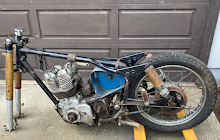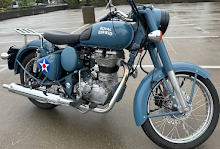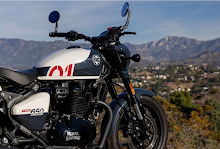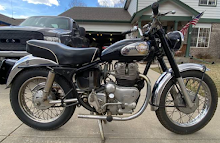 Now that my Royal Enfield Bullet doesn't commute to work every day, it will "wet sump." That is, oil in the timing gears halfway up the motor gradually leaks down into the crankshaft space below the piston. On starting, any oil here is flung against the bottom of the piston, finds its way into the combustion chamber and is burned off in a cloud of white smoke.
Now that my Royal Enfield Bullet doesn't commute to work every day, it will "wet sump." That is, oil in the timing gears halfway up the motor gradually leaks down into the crankshaft space below the piston. On starting, any oil here is flung against the bottom of the piston, finds its way into the combustion chamber and is burned off in a cloud of white smoke.It's embarrassing. It coats the spark plug with oil. And it's also potentially harmful to the motor. One school of thought has it that the scavenger oil pump assigned to keep the dry sump clear is overtaxed by this sudden load of thick, cold oil at start-up and could strip its gears. Meanwhile, the lack of oil in the upper parts of the engine is contributing to wear there.
The best way to solve this problem might be to ride every day, keeping the seepage effect to a minimum. But since even I can't do that here in Florida, it's unrealistic to expect people in colder parts of the country to do it through the winter.
Luckily, Royal Enfield provides a separate drain plug for the dry sump: the forward drain plug. Drain the few ounces of oil accumulated there, pour it back into the oil tank under the dipstick/cap, and all is well. Except, well, it's a messy job.
Early in the history of U.S. imports of Royal Enfields to the United States, Kevin Mahoney of Classic Motorworks learned of a handy way to do it. On May 21, 1999, he posted this tip on the CMW web site:
"When your Bullet has not been started for a period of time it is common for a fair amount of oil to seep out of the system and fill the 'dry-sump' crankcase. This happens on many British bikes and Harleys. This is evidenced in a Harley by a puddle of oil on the floor (larger than usual) and in the Bullet by a smoking exhaust and sometimes oil from the tailpipe. This is a normal condition. It can be eliminated or reduced by doing the following. Take a 1 gallon plastic milk container and cut the top 1/2 off. Place it under the front of the engine, loosen the sump drain bolt (the most forward placed of the drain bolts) and drain off the oil which has collected in the sump. You will find that the sump plug fits perfectly in hole which used to be the handle! When the oil has drained, pour it back into the oil tank or top it off with fresh oil."
Sounds good. I decided to give it a try. First it was necessary to visualize exactly what Kevin was suggesting: don't cut off the entire top of the milk jug; leave as much "meat" as you can, cutting across the handle to leave a nice hole for the sump plug to sit in.
The first surprise I encountered is how flimsy a plastic milk jug is when you cut off much of the top. It's wobbly and weak. Still, it worked as Kevin predicted as far as collecting the oil and holding the sump plug.
But when I went to pour the collected oil back into the oil tank the milk jug deformed unevenly and spilled most of the oil on the ground. I might have been OK if I had poured it carefully into a funnel rather than trying to aim directly at the narrow oil tank opening.
This is one tip that is not yet ready for prime time. I'm keeping my eyes open for a plastic bottle with more strength.

























No comments:
Post a Comment